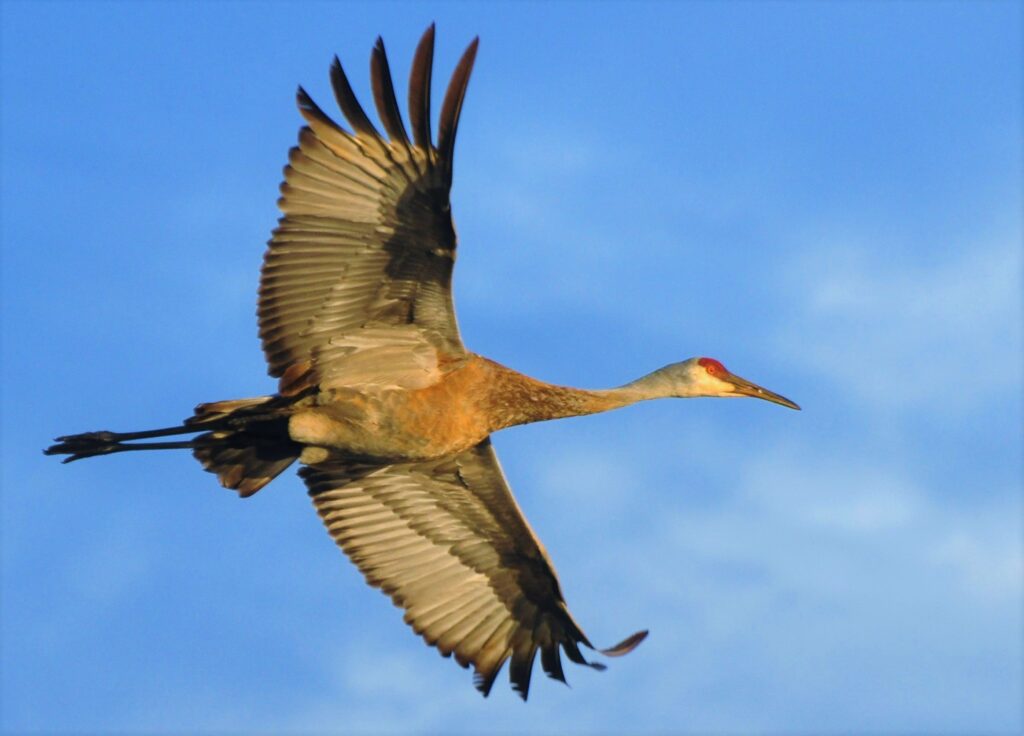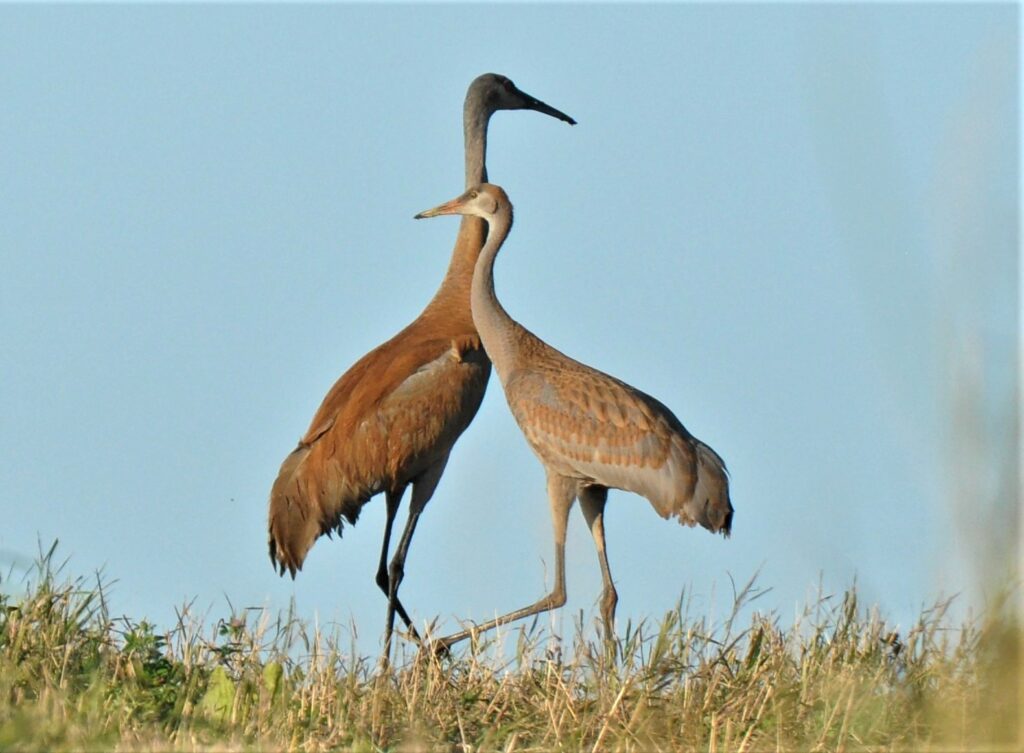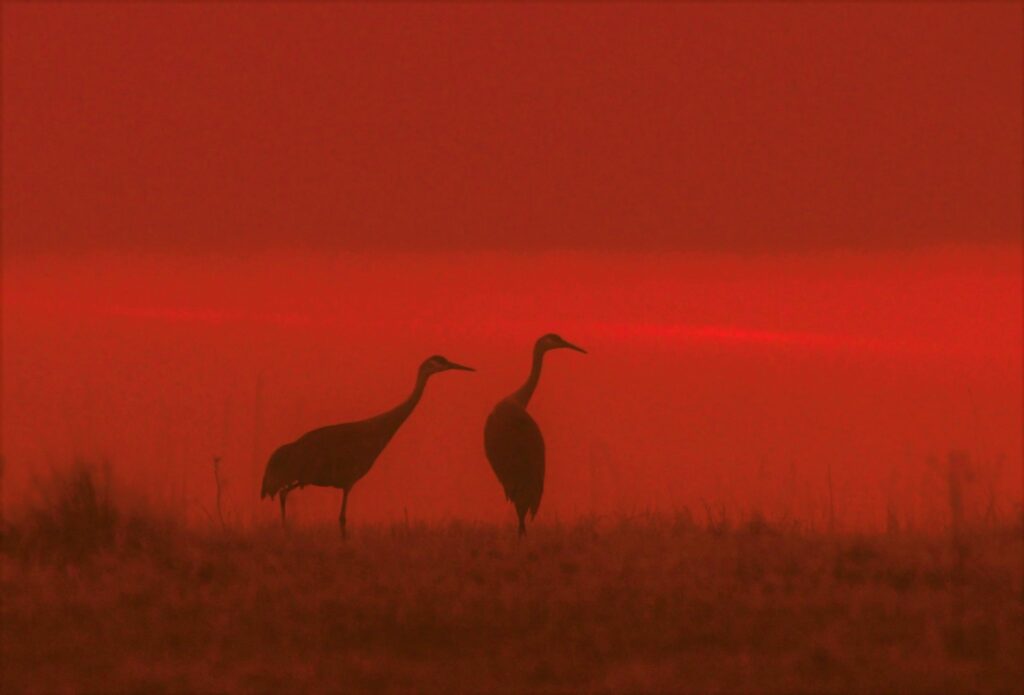Photography courtesy of Lowell Washburn, all rights reserved.
With its four-foot height, six-foot wingspan, ear piercing call, and penetrating stare; the crimson-capped sandhill crane is about as charismatic as a wild bird can get. During spring courtship, crane pairs conduct flamboyant rituals with birds engaging in unison calling while simultaneously conducting graceful wing extensions before leaping into the air in a dramatic and perfectly choreographed nuptial dance. As if that weren’t enough to garner our attentions, the crane is also credited with having the loudest voice of any bird. Under ideal conditions, the crane’s rolling elephant-like trumpeting can literally be heard for miles. Extremely wary, nesting adults stay as far from humans as possible. Their nest sites and newly hatched young are rarely observed.

Wild cranes were once common inhabitants of Iowa bogs and marshlands. During the 1800s, crane flocks containing hundreds, and even thousands of birds, were documented across northern Iowa. But times change. Following the arrival of European settlers, crane numbers began to rapidly dwindle. Relentlessly hunted for food and feathers, pressured by the advent of wholesale wetland drainage, and eventually plagued by the growing popularity of wild bird egg collections; crane populations crashed and then disappeared entirely by around 1900. The state’s last known nesting of sandhill cranes occurred in May of 1894 on a marsh located near Hancock County’s Eagle Lake. This final nesting attempt was unsuccessful when egg collectors looted the nest.
At another nearby wetland, the last breeding pair of Iowa whooping cranes was also setting on eggs. By now, both crane species had become exceedingly rare and serious collectors were paying a premium for their eggs or skins. Consequently, the female whooper was shot while sitting on the nest; her hide and eggs promptly collected. Although the male was pursued at length, the bird eluded capture and was finally driven from the area. A remarkable display of short-sighted greed, the shameful incident marked the very last time that a pair of whooping cranes attempted to nest anywhere in the continental United States. Today, the only self-sustaining population of whooping cranes breeds in northern Canada and winters in Texas. Biologists, mainly as a result of captive breeding projects, are currently attempting to reestablish three whooper populations in the Lower ’48. The closest attempt is in Wisconsin.
Faring somewhat better than their larger cousins, a fragile mid-continent population of sandhill cranes managed to survive within the undeveloped reaches of Wisconsin, Minnesota, and Michigan. These birds have shown significant gains during recent years and are currently expanding their Midwestern range. In 1992, breeding sandhill cranes returned to Iowa when two successful nests were documented at Tama County’s Otter Creek Wildlife Area.

Hatched in 2019, a nearly grown sandhill crane colt [foreground] accompanies its mother at the Bennet Smith wetland located near Clear Lake’s south shore
Following an absence of more than a century, wild sandhill cranes returned to Northern Iowa’s Cerro Gordo County – the county where I live — when an adult pair set up housekeeping on the 992-acre Ventura Marsh in 2010. After several mornings of following the clamor of their brief daybreak displays, I was finally able to pinpoint their over-the-water nesting platform in a shallow and secluded opening near the big marsh’s southern shore. The following day, I erected a tiny photo blind while the pair was away on break. I continued to surveil the site until, at long last, the mottled cinnamon-colored egg pipped, cracked open, and the long-anticipated colt emerged. Within two hours of hatch, the golden newborn was already up and running as it explored the nooks and crannies of the nest platform. For me, it was a unique thrill to observe history in the making.

History in the Making – Following more than a century of absence, nesting sandhill cranes officially returned to Cerro Gordo County when this newborn colt was successfully hatched at the Ventura Marsh in 2010. Today, nesting cranes are becoming an increasingly common component of the North Iowa landscape.
As they continue to expand their range and reclaim historic habitats, wild cranes are now nesting in more than 40 Iowa counties; about double the number of nests tallied in 2010. At this point in time, the crane’s future in Iowa indeed seems bright.


 Tom Cope
Tom Cope Sue Wilkinson
Sue Wilkinson Susan Judkins Josten
Susan Judkins Josten Rudi Roeslein
Rudi Roeslein Elyssa McFarland
Elyssa McFarland Mark Langgin
Mark Langgin Adam Janke
Adam Janke Joe Henry
Joe Henry Kristin Ashenbrenner
Kristin Ashenbrenner Joe Wilkinson
Joe Wilkinson Dr. Tammy Mildenstein
Dr. Tammy Mildenstein Sean McMahon
Sean McMahon